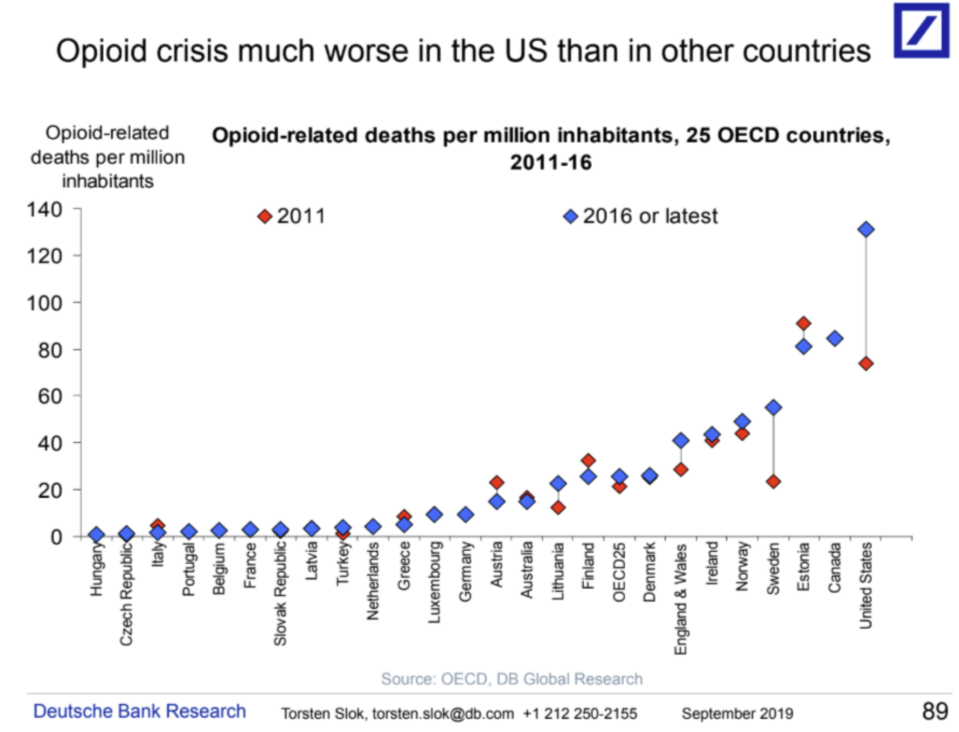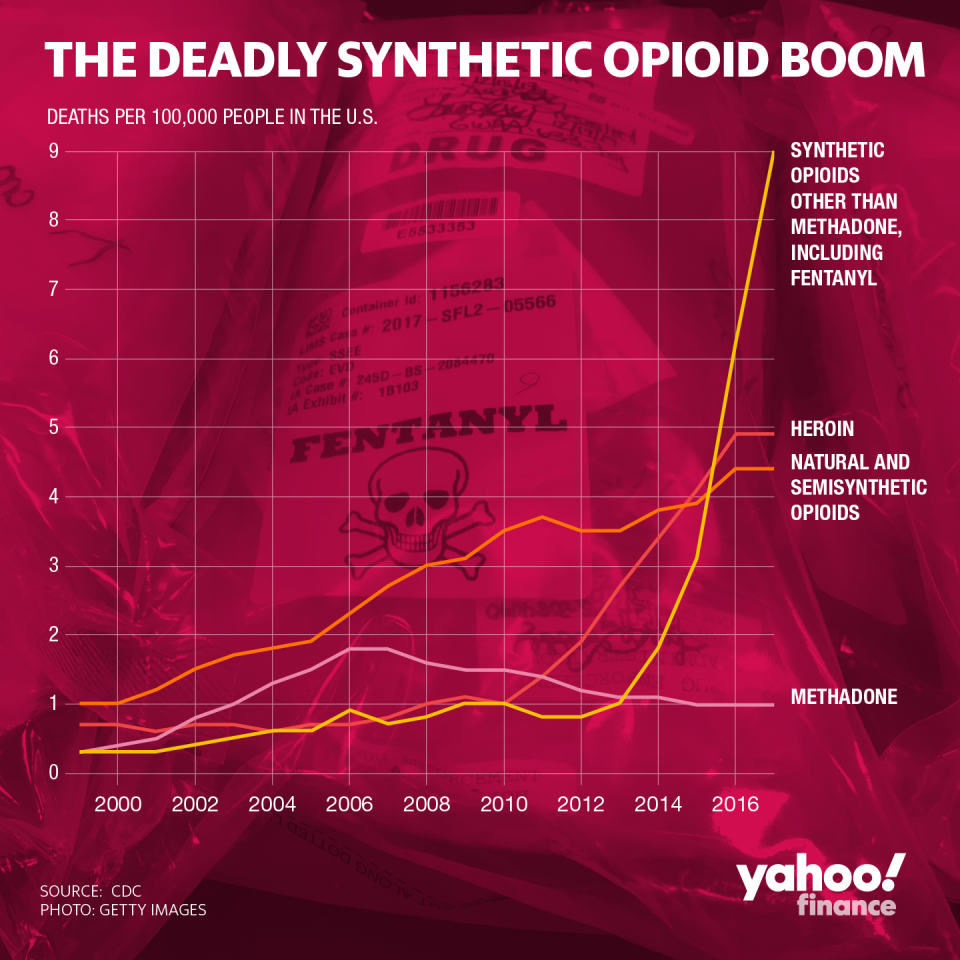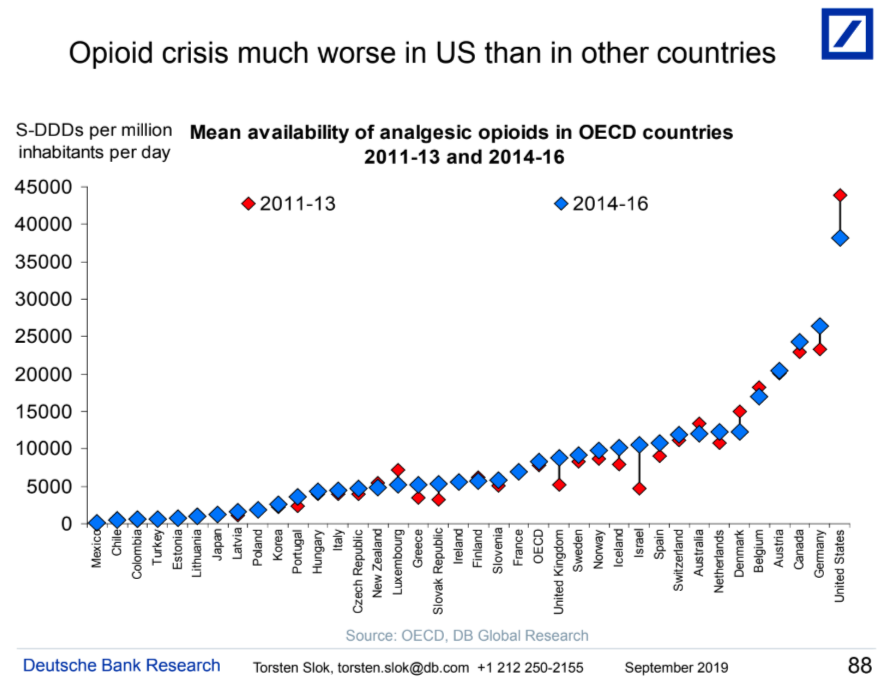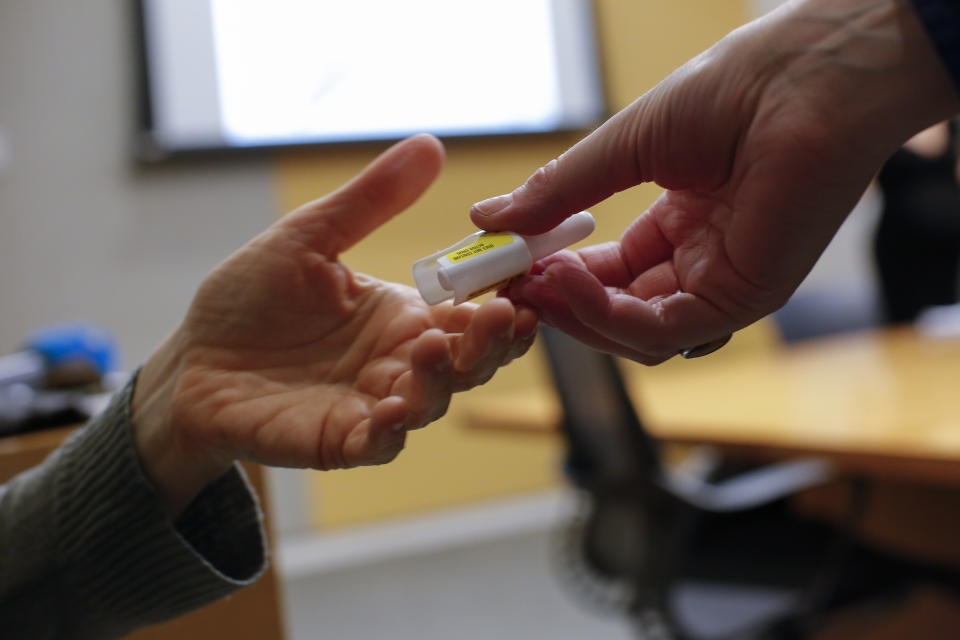The uniquely American opioid crisis, in 3 charts
Opioids have hit the U.S. hard in the 21st century. Several pharmaceutical companies, like Purdue Pharma and Johnson and Johnson (JNJ), have faced lawsuits related to how their companies marketed opioids.
And according to data from Deutsche Bank Research, opioid-related deaths per million inhabitants has drastically increased in the U.S. compared to the other Organization for Economic Cooperation and Development (OECD) countries.
It surged from just under 80 deaths per million inhabitants to over 120 from 2011 to 2016. The next two closest countries are Canada and Estonia, who are both between 85-90 deaths per million inhabitants.

‘What’s really driven the number ... is the way fentanyl has penetrated’ the U.S.
So why such a disparity? According to Dr. Bradley Stein, the director of the RAND Opioid Policy Center, there are a variety of factors.
“We have probably a larger percentage of our population who is struggling with [opioids],” he told Yahoo Finance. “We have many individuals now who are turning to the illicit markets and are exposed to heroin and fentanyl, which are more likely to cause overdose. For a whole variety of reasons, I don’t find it surprising that we have more overdose deaths.”
Between 2016 and 2017, synthetic opioid overdose deaths (including fentanyl) spiked 45%. Fentanyl can be 50 to 100 times more potent than morphine. And according to the National Institute of Health (NIH), “synthetic opioids, including fentanyl, are now the most common drugs involved in drug overdose deaths in the United States.”

“What’s really important to understand in the U.S. is that probably in the last three or four years, what has really driven the number of opioid-related deaths is the way fentanyl has penetrated substantial parts of the U.S.,” Stein said. “That big jump you see from 2011 to 2016, I think in a lot of ways, may be due to the opioid crisis overall, but certainly what we’re seeing in terms of fentanyl penetrating communities and just so many more deaths resulting from that.”
Cristian Herrera, health policy analyst at the OECD, said the U.S. problem started with “the issue of prescription and overprescription of opioids” in the health care system.
“Medical doctors and other prescribers started to use this to treat pain, but in the end, they started to become dependent on it,” he told Yahoo Finance.
Once the U.S. began enacting more regulations, people moved to the illegal market and started using heroin, Herrera explained. From there came the creation of synthetic opioids, like fentanyl and carfentanil. The combination of these factors is what “created the crisis” in the U.S. and Canada.
Big pharma companies ‘absolutely were a large piece of this’
Much of the U.S. overdose crisis has to do with the role of pharmaceutical companies. Purdue Pharma, the creator of OxyContin, and Johnson & Johnson reached settlements earlier this year over lawsuits alleging their responsibility in fueling the U.S. overdose crisis. J&J then announced it would be settling two Ohio opioid lawsuits for $20 million to avoid trial.
“Certainly what pharma has done has contributed to it substantially,” Stein said. “As we have learned and as documents come out during some of these cases, pharma certainly did a number of things that all seem to enhance the likelihood that physicians would be much more liberal in their prescribing of opiate analgesics. So, I think they absolutely were a large piece of this.”
Stein describes this issue within the U.S. as part of the “prescribing culture.”
“You had a situation here where if you go back to the early ‘90s, we probably weren’t doing as good a job treating pain as we probably should have been as a country,” he said. “But then, what you start to have happen is this effort through marketing to then diminish or not really communicate to doctors the risks that came along with prescribing opiate analgesics, or very much downplay those risks.”

The lawsuits that pharmaceutical companies are facing have much to do with their marketing tactics. Johnson & Johnson was ordered to pay $572 million to the state of Oklahoma for what the judge ruled as a breach of the state’s public nuisance law by using “false, misleading, and dangerous marketing campaigns [that] have caused exponentially increasing rates of addiction, overdose deaths, and Neonatal Abstinence Syndrome.” Purdue Pharma also faced lawsuits from its marketing practices, eventually reaching a $3 billion settlement in September 2019.
“It took what was potentially well-meaning, well-intentioned policy, and there were these unintended consequences,” Stein said. “One of the things we clearly saw in the United States is because of this effort, you did have far more opiate analgesics.”
He continued: “Now, there are probably aspects of the U.S. that made it more likely this would occur here than in another country, one of which is probably just the opportunity to profit. In other countries where they may have far greater controls on the profits that can be made from medications, companies may not have had the incentive to market as aggressively.”

Ways to control the crisis
The jarring stats are all the more reason to find ways to improve the system, experts say.
“We say that there are four areas where countries can take action to control this [crisis],” Herrera said. “The first area, the health system. Countries should invest and should develop policies in the area of prevention ... and regulate the relationship with the manufacturers.
Social policy is another area, which can help people with housing, employment support, and rehabilitation. Improvement and knowledge of opioid use is the third area to focus on. The fourth are, according to Herrera, is regulation and enforcement.
“We need to find ways to decrease the likelihood that people are going to begin to develop opioid problems and prevent people from going down that road,” Stein said. “For people who have those problems, we need to make our treatment system more robust, and we need to focus on the naloxone of another harm reduction to decrease overdose deaths. I think we can do all of those things given where we’re at now in the crisis.”
Adriana is an associate editor for Yahoo Finance. Follow her on Twitter @adrianambells.
READ MORE:
'They thought they were buying heroin': How fentanyl invaded the U.S.
Read the latest financial and business news from Yahoo Finance
Follow Yahoo Finance on Twitter, Facebook, Instagram, Flipboard, SmartNews, LinkedIn, YouTube, and reddit.